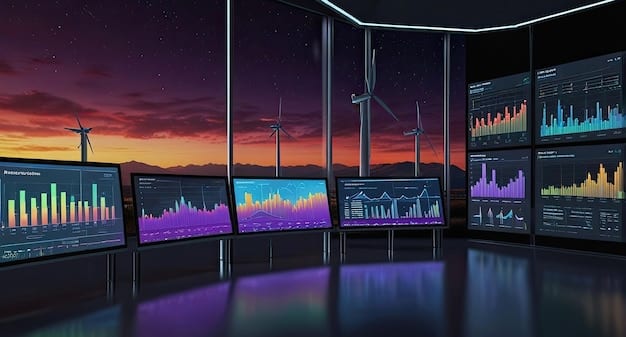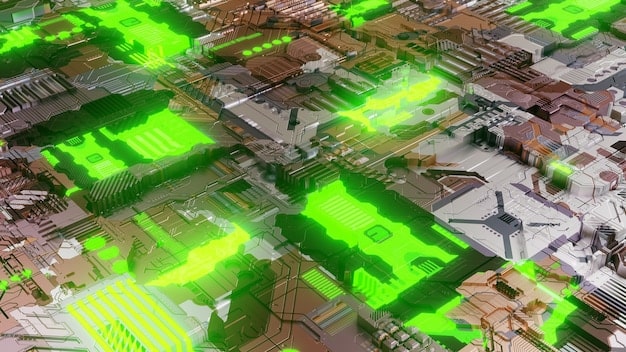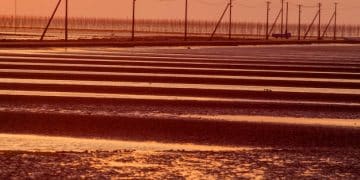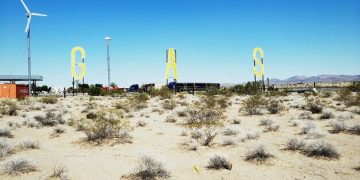Integrating DERs into the US Grid: Opportunities and Challenges

Integrating Distributed Energy Resources (DERs) into the US grid presents significant opportunities for enhancing grid resilience, promoting clean energy adoption, and empowering consumers, but also poses challenges related to grid stability, regulatory frameworks, and cybersecurity.
The integration of distributed energy resources (DERs) is rapidly transforming the landscape of the US power grid. What are the Opportunities and Challenges of Integrating Distributed Energy Resources (DERs) into the US Grid? This article delves into the multifaceted aspects of this integration, exploring the potential benefits and hurdles that lie ahead.
Understanding Distributed Energy Resources (DERs)
Distributed Energy Resources (DERs) are small-scale power generation or storage technologies located close to the end-users. They offer an alternative to traditional centralized power generation and can significantly impact how electricity is generated, distributed, and consumed.
DERs encompass a variety of technologies, each with unique characteristics and applications. Their integration into the grid promises to reshape the energy sector, but it also requires careful planning and execution.
Types of Distributed Energy Resources
DERs can be categorized into several types based on their function and technology. Understanding these different types is crucial for assessing their potential impact on the grid.
- Solar PV Systems: These convert sunlight directly into electricity using photovoltaic panels, suitable for residential, commercial, and utility-scale applications.
- Wind Turbines: Harnessing wind energy to generate electricity, wind turbines can be installed individually or in wind farms, contributing significantly to renewable energy production.
- Energy Storage Systems: Including batteries, flywheels, and pumped hydro storage, these systems store energy for later use, enhancing grid stability and reliability.
- Combined Heat and Power (CHP): CHP systems generate electricity and heat simultaneously, improving energy efficiency and reducing overall energy consumption.

DERs represent a paradigm shift in energy generation and distribution. By understanding their various types, stakeholders can better appreciate their potential benefits and challenges.
Opportunities for DER Integration
Integrating DERs into the US grid presents numerous opportunities, ranging from enhanced grid resilience to increased consumer empowerment. These benefits highlight the transformative potential of DERs in shaping a more sustainable and efficient energy future.
The advantages of DER integration are not limited to environmental benefits; they also include economic and social aspects that can positively impact communities and businesses across the country.
Enhancing Grid Resilience
DERs can significantly improve grid resilience by providing backup power during outages and reducing reliance on centralized generation. This distributed nature of DERs makes the grid less vulnerable to large-scale disruptions.
With DERs spread across different locations, a failure in one area does not necessarily lead to a widespread blackout. This localized generation capability can keep critical services operational during emergencies.
Promoting Clean Energy Adoption
DERs, particularly solar and wind, play a crucial role in promoting clean energy adoption by reducing dependence on fossil fuels. They contribute to a cleaner energy mix and help meet environmental sustainability goals.
- Reduced Carbon Footprint: DERs lower greenhouse gas emissions, mitigating climate change and improving air quality.
- Renewable Energy Targets: DERs help states and the nation meet renewable energy targets and mandates.
- Energy Independence: By diversifying energy sources, DERs reduce reliance on imported fossil fuels.
DER integration is a key strategy for transitioning to a cleaner and more sustainable energy system. The environmental benefits are substantial and contribute to a healthier planet.
Challenges of DER Integration
Despite the numerous opportunities, integrating DERs into the US grid also presents significant challenges. These challenges range from technical issues related to grid stability to regulatory and economic barriers that need to be addressed for successful integration.
Overcoming these challenges requires collaboration among utilities, regulators, policymakers, and technology providers to create a supportive ecosystem for DER deployment.

Grid Stability Concerns
The intermittent nature of some DERs, such as solar and wind, can create challenges for grid stability. Fluctuations in power output can lead to voltage and frequency imbalances, affecting the overall reliability of the grid.
Managing these fluctuations requires advanced grid management technologies, such as smart inverters and energy storage systems, to smooth out the supply and demand balance.
Regulatory and Economic Barriers
Regulatory frameworks and economic incentives play a crucial role in DER integration. Inconsistent policies and inadequate compensation mechanisms can hinder DER deployment and discourage investment.
Net metering policies, interconnection standards, and tariff structures need to be updated to reflect the value of DERs and ensure fair compensation for DER owners.
- Standardized Interconnection Procedures: Streamlining the interconnection process reduces costs and delays for DER projects.
- Fair Compensation Mechanisms: Ensuring DER owners receive fair compensation for the energy they contribute to the grid.
- Updated Tariff Structures: Developing tariff structures that reflect the true costs and benefits of DERs.
Addressing regulatory and economic barriers is essential for creating a level playing field for DERs and encouraging their widespread adoption.
Technological Solutions for DER Integration
Technological advancements play a critical role in overcoming the challenges of DER integration. Smart grid technologies, advanced inverters, and energy storage systems are key enablers for integrating DERs seamlessly into the grid.
These technologies not only address the technical challenges but also enhance the overall efficiency and reliability of the grid, making it more resilient and adaptable.
Smart Grid Technologies
Smart grid technologies enable real-time monitoring, control, and optimization of the grid, facilitating the integration of DERs and improving overall grid management. These technologies provide the necessary tools to manage the complexities introduced by DERs.
Advanced sensors, data analytics, and communication networks enable utilities to monitor grid conditions, predict potential issues, and respond quickly to changes in supply and demand.
Advanced Inverters
Advanced inverters are crucial for connecting DERs to the grid and ensuring stable and reliable power delivery. These inverters offer advanced functionalities, such as voltage and frequency regulation, that help maintain grid stability.
Smart inverters can also provide grid support services, such as reactive power compensation, to further enhance grid stability and reliability.
Policy and Regulatory Recommendations
Effective policies and regulatory frameworks are essential for promoting DER integration and addressing the associated challenges. These policies should be designed to incentivize DER deployment, ensure fair compensation, and protect grid stability.
Collaboration among policymakers, regulators, utilities, and stakeholders is crucial for developing comprehensive and forward-looking policies that support the transition to a more distributed and sustainable energy system.
Incentivizing DER Deployment
Financial incentives, such as tax credits, rebates, and grants, can encourage DER deployment by reducing the upfront costs and improving the economic viability of DER projects. These incentives can be targeted at specific DER technologies or customer segments.
Performance-based incentives can also be used to reward DER owners for providing grid support services and contributing to grid stability.
Ensuring Fair Compensation
Net metering policies, feed-in tariffs, and value-of-solar tariffs are examples of compensation mechanisms that ensure DER owners receive fair compensation for the energy they contribute to the grid. These mechanisms should be designed to reflect the true value of DERs, including their environmental and grid support benefits.
- Standardized Net Metering: Implementing consistent net metering policies across different states and utilities.
- Feed-in Tariffs: Offering guaranteed payments for electricity fed into the grid from DERs.
- Value-of-Solar Tariffs: Compensating DER owners based on the value of the electricity they provide to the grid.
Fair compensation mechanisms are essential for creating a sustainable market for DERs and encouraging their widespread adoption.
Future Trends in DER Integration
The future of DER integration is characterized by several key trends, including increased adoption of energy storage, advancements in smart grid technologies, and the development of microgrids. These trends promise to further transform the energy landscape and accelerate the transition to a more distributed and sustainable energy system.
These future trends will not only improve the efficiency and reliability of the grid but also empower consumers and create new opportunities for innovation and economic growth.
| Key Point | Brief Description |
|---|---|
| 💡 Grid Resilience | DERs enhance grid stability by providing backup power and reducing reliance on centralized generation. |
| 🌱 Clean Energy | Solar and wind DERs reduce dependence on fossil fuels, contributing to a cleaner energy mix. |
| 🛡️ Grid Stability Concerns | Intermittent DERs can cause voltage and frequency imbalances, requiring advanced grid management. |
| ⚖️ Regulatory Barriers | Inconsistent policies and inadequate compensation mechanisms can hinder DER deployment. |
FAQ
▼
Distributed Energy Resources (DERs) are small-scale power generation or storage technologies located close to the end-users. They include solar PV systems, wind turbines, and energy storage.
▼
DERs enhance grid resilience by providing backup power during outages and reducing reliance on centralized generation, making the grid less vulnerable to disruptions.
▼
The main challenges include grid stability concerns due to intermittent power sources and regulatory and economic barriers that hinder DER deployment and investment.
▼
Smart grid technologies enable real-time monitoring, control, and optimization of the grid, facilitating the integration of DERs and improving overall grid management.
▼
Policy recommendations include incentivizing DER deployment through financial incentives, ensuring fair compensation through net metering, and updating regulatory frameworks to support DERs.
Conclusion
Integrating Distributed Energy Resources (DERs) into the US grid presents a transformative opportunity to enhance grid resilience, promote clean energy adoption, and empower consumers. While challenges related to grid stability, regulatory frameworks, and cybersecurity persist, technological solutions and effective policies can pave the way for a more distributed and sustainable energy future.





